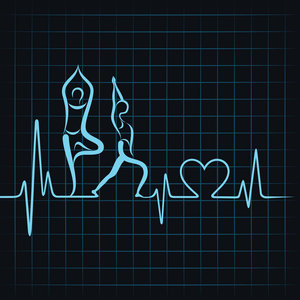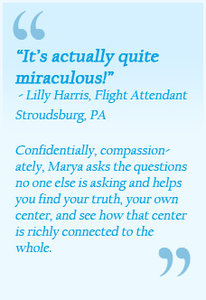Your Heart on Yoga

The incredible feats of this small organ are astonishing. The heart is the rhythm-maker, the emperor of our emotions, and the conductor of our inner music, the symphony of sensation, feeling, thought, intention, action, and memory.
Although it’s only about the size of a fist and weighs just eight to ten ounces, the heart commands the organ systems, animates the spine, and coordinates the four extremities by circulating prana, the lifeforce, through the blood to nourish all of your 37 trillion cells.
The ruler of the body, it reigns over all the blood vessels — arteries, capillaries, and veins – which if laid end to end, would reach 60,000 miles.
Yoga nourishes these inner rivers and streams while opening the heart and resting the mind. All systems of the body —- neural, digestive, immune, respiratory and glandular, as well as the cardiovascular systems – hum along in balance.
Heart Disease is our World’s #1 Problem
Modern life being what it is, stress is killing a lot of people. When the heart starts racing because of annoyance or pain, we constrict the chest, which leads to cardiovascular disease (CVD) – the leading cause of death in Hawaii, the nation and the world, representing 31% of all global deaths.
Heart disease does not have to kill. If we care for the heart, it will care for us. During yoga practice, the heart goes through physiological and energetic changes that engage new awareness leading to better choices. Conscious breathing reduces muscle tension and massages the physical heart, carrying fresh prana with the blood into connective tissue, loosening stagnant energy and old tension patterns.
Yoga eases that tension through specific attention, breathing, and movement methods that transform the shape of the body and the rhythms of the heart and mind. More than 70 published studies spanning 34 years have demonstrated a clear link between yoga and well-being in both healthy and unhealthy adults.
Yoga reduces blood pressure, balances blood sugar and cholesterol levels and improves hormonal balance. Improved moods, decreased stress and better quality sleep enhance mental states as well, which also helps prevent heart disease.
How does this transformation take place?
The Vagus Nerve
Yoga stimulates the amazing vagus nerve, also known as “the wanderer” because this tenth cranial nerve meanders its vast network of fibers through all your organs and fascia.
When the vagus nerve is happy, we’re happy. Deep breathing fills the lungs with oxygen and sends waves of movement through all the tissues, toning the vagus nerve and soothing inflammation. When stimulated by yoga, the vagus nerve initiates your body’s relaxation response and lowers heart rate. People with vagal tone seem to recover more quickly after stress, injury, trauma or illness.
Intensity vs. Stress
A deep stretch, new alignment, or more precise effort can generate intense sensation. Someone who is not used to intensity may identify such a sensation as pain or stress, preventing them from moving past their perceived limits. While it is never a good idea to go too far or push ourselves too hard, discerning the difference between a fear of intensity and real pain is key to one of Yoga’s greatest rewards. Described by the sage Patanjali in the Yoga Sutra, the supreme benefit of Yoga is calming the fluctuations in the mind.
We do that by becoming conscious of unnecessary chatter, negative emotions, and intense feelings without getting caught up in them. In yoga, through movement, breathwork, sound, and concentration, we generate voluntary intensity deliberately. Then, we increase the currents of positive energy to transform awareness as it percolates through body and mind.
Spreading the Joy
Scientists at the HeartMath Institute found that the heart generates the largest electromagnetic field in the body, 60 times greater than the brain’s field. “It can be detected and measured several feet away from a person’s body and between two individuals in close proximity,” writes Rollin McCraty, Ph.D., Director of Research at the institute.
Consciously choosing what emotions we feel – love and happiness rather than anger or bitterness – “intimately” tied to our heart’s coherence and radiance. To unfold the energetic lotus of your feeling heart as well as your physical heart, breathing practices help.
Heart Breathing
Close your eyes and turn your attention inward after reading this instruction:
Breathe through the nose unless the sinuses are congested. Seated comfortably, breathe in and out through the heart. Be still, quiet and take this time to witness your innermost self. Drop beneath the mind chatter into the soft spot in your heart. Recall a time you felt joyful, peaceful. Feel your heartbeat.
Breathe into the heart, counting 1-2-3-4. Hold 1-2-3-4. Exhale from the heart, 1-2-3-4. Hold 1-2-3-4, relaxing. If you can effortlessly extend the breath, breathe in for 1-8 counts, hold for 5 or 8 seconds. Don’t grip or force anything. Breathe out for 8. Hold for 5 at the end. Relax.
Do this again and again. It takes practice sometimes to get quiet and be willing to connect deeply with your heart and inner rhythm. If it seems challenging, that’s why we’re doing the practice. Seek and find the inner harmony underneath the chatter.
Remember that worrying doesn’t take away tomorrow’s troubles. It only robs you of tuning into the beautiful music your heart is making today.
———————————————————————
Resources for heart coherence can be found at www.Heartmath.org
Marya Mann, Ph.D., writes the monthly Yoga column for West Hawaii Today and teaches at Kona Dance and Performing Arts Studio, New Thought Center and Yano Hall. She offers Energy Medicine sessions at Kona Coast Wellness and the Lotus Spa at the Royal Kona Resort. She can be reached at marya.mann@gmail.com


